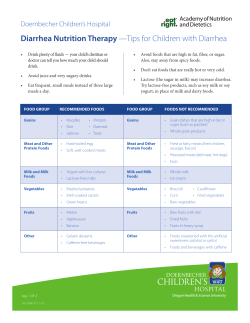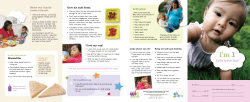
Document 84160
Client Name ______________________________________ Date ________________ RD/DTR ______________________________________________________________ Email ____________________________________ Phone ______________________ High-Fiber Foods List • Fiber and fluid may help you feel less constipated and bloated and can also help ease diarrhea. • Increase fiber slowly over the course of a few weeks. This will keep your symptoms from getting worse. Tips for Adding Fiber to Your Eating Plan • Slowly increase the amount of fiber you eat to 25 to 35 grams per day. • Eat whole grain breads and cereals. Look for choices with 100% whole wheat, rye, oats, or bran as the first or second ingredient. • Have brown or wild rice instead of white rice or potatoes. • Enjoy a variety of grains. Good choices include barley, oats, farro, kamut, and quinoa. • Bake with whole wheat flour. You can use it to replace some white or all-purpose flour in recipes. • Enjoy baked beans more often! Add dried beans and peas to casseroles or soups. • Choose fresh fruit and vegetables instead of juices. • Eat fruits and vegetables with peels or skins on. • Compare food labels of similar foods to find higher fiber choices. On packaged foods, the amount of fiber per serving is listed on the Nutrition Facts label. • Drink plenty of fluids. Set a goal of at least 8 cups per day. You may need even more fluid as you eat higher amounts of fiber. Fluid helps your body process fiber without discomfort. Notes: Copyright © American Dietetic Association. This handout may be duplicated for client education. High-Fiber Foods List – Page 1 Recommended Foods Foods with at Least 4 g Fiber per Serving Food Group Choices ⅓-½ cup high-fiber cereal (check Nutrition Facts labels and choose Grains products with at least 4 g dietary fiber per serving) Dried beans ½ cup cooked red beans, kidney beans, large lima beans, navy beans, pinto beans, white beans, lentils, or black-eyed peas and peas 1 artichoke (cooked) Vegetables ½ cup blackberries or raspberries Fruits 4 dried prunes Foods with 1 to 3 g Fiber per Serving Food Group Grains Fruits Choices 1 bagel (3.5-inch diameter) 1 slice whole wheat, cracked wheat, pumpernickel, or rye bread 2-inch square cornbread 4 whole wheat crackers 1 bran, blueberry, cornmeal, or English muffin ½ cup cereal with 1-3 g fiber per serving (check dietary fiber on the product’s Nutrition Facts label) 2 tablespoons wheat germ or whole wheat flour 1 apple (3-inch diameter) or ½ cup applesauce ½ cup apricots (canned) 1 banana ½ cup cherries (canned or fresh) ½ cup cranberries (fresh) 3 dates 2 medium figs (fresh) ½ cup fruit cocktail (canned) ½ grapefruit 1 kiwi fruit 1 orange (2½-inch diameter) 1 peach (fresh) or ½ cup peaches (canned) 1 pear (fresh) or ½ cup pears (canned) 1 plum (2-inch diameter) ¼ cup raisins ½ cup strawberries (fresh) 1 tangerine Copyright © American Dietetic Association. This handout may be duplicated for client education. High-Fiber Foods List – Page 2 Foods with 1 to 3 g Fiber per Serving Food Group Vegetables Other Choices ½ cup bean sprouts (raw) ½ cup beets (diced, canned) ½ cup broccoli, brussels sprouts, or cabbage (cooked) ½ cup carrots ½ cup cauliflower ½ cup corn ½ cup eggplant ½ cup okra (boiled) ½ cup potatoes (baked or mashed) ½ cup spinach, kale, or turnip greens (cooked) ½ cup squash—winter, summer, or zucchini (cooked) ½ cup sweet potatoes or yams ½ cup tomatoes (canned) 2 tablespoons almonds or peanuts 1 cup popcorn (popped) Notes: Copyright © American Dietetic Association. This handout may be duplicated for client education. High-Fiber Foods List – Page 3
© Copyright 2025













